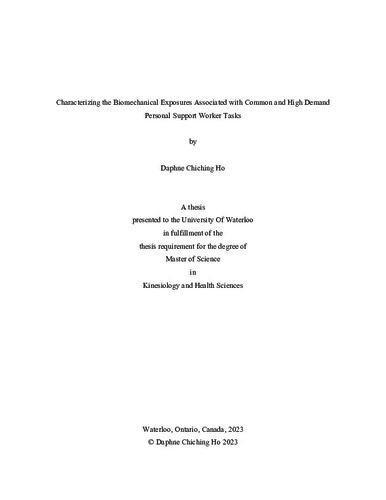| dc.description.abstract | Background:
The physical demands that personal support workers (PSWs) are exposed to are increasing as our population ages and our society is increasingly shifting to at-home care, resulting in increases in workload demands. However, PSWs are also developing high rates of musculoskeletal disorders (MSD) likely because of increased exposure to physical task demands. There is a need to intervene to protect these essential healthcare workers. Presently, little is known about the biomechanical exposure characteristics associated with PSW work tasks, especially within a home care setting. PSW work is highly dynamic and a wide range of tasks with different loading scenarios are completed. This means that the time-series exposure patterns are also likely varied over a work shift or work week, where this variation may be important when designing effective ergonomic interventions. As an example intervention strategy, workload management may be an effective approach to monitor, assess, and redistribute workload as needed to provide recovery windows to reduce and mitigate the accumulation of exposure. Real-time tracking and the continuous monitoring of PSW exposures, or surrogates, may assist in the assessment of injury risk.
To better understand the biomechanical exposure characteristics associated with common PSW work tasks and to explore the potential utility of ratings of perceived exertion (RPE) as a potential surrogate measure to track PSW workload, this thesis aimed to address the following two objectives and corresponding research questions:
Objectives:
1. Characterize biomechanical exposure metrics associated with the performance of common and highly demanding PSW work tasks.
2. Evaluate the relationship between RPE and the biomechanical exposure metrics.
Research Questions:
1. What are the biomechanical exposures experienced by PSWs when performing simulated common and physically demanding work tasks?
2. What is the relationship between RPE and biomechanical exposure metrics (peak low back flexion angle, peak low back extensor moment, cumulative low back extensor moment) when performing common and physically demanding PSW work tasks?
Methods:
Twenty PSWs were recruited to complete 12 work tasks within a laboratory setting, where full body kinematics and hand forces were collected for all trials. A whole-body top-down rigid link modelling approach was used to calculate biomechanical exposure metrics. Peak low back flexion angle along with peak and cumulative extensor moments were calculated. Linear regressions tested for relationships between post-task RPE scores and 1) peak low back angles, 2) peak low back extensor moment, and 3) cumulative low back extensor moment at an individual level, where corresponding regression statistics from each participant were the aggregated at the group level.
Results:
Patient handling tasks, such as transfers and repositioning tasks, had the highest peak extensor moments (ranging from 115-157 Nm), while having the lowest cumulative moment values (1329 – 4552 Nm*s). In contrast, patient care tasks such as bathing, dressing/undressing, and compression stocking application, had the highest cumulative extensor moment values (2623 – 8089 Nm*s) and lower peak moments (92 – 107 Nm). Additionally, patient care tasks took the longest to complete and required participants to frequently adopt moderate (20-45 degrees) to severe (>45 degrees) levels of low back flexion.
A significant moderate positive relationship was found between RPE scores and cumulative low back extensor moment (p<0.05, R=0.60). No significant relationship was found between RPE scores and both peak low back flexion angle (p<0.05, R=0.16) and peak low back extensor moment (p<0.05, R=-0.13).
Discussion:
The biomechanical exposure characteristics of PSW work are task dependent. Patient handling tasks subjected PSWs to high peak loads for brief periods of time. Patient care tasks, on the other hand, imposed lower magnitudes of loading for extended time duration. It is well established that low back injury pathways are different when loading is high, but brief, relative to lower in magnitude, but sustained. As such, it appears that groupings of tasks may be of more interest to consider and intervene from the perspective of reducing high peak loads, where others might be better viewed from a cumulative load perspective. Therefore, in the design and development of any effective ergonomic interventions, it may be important to consider task-specific loading profiles and how they may influence injury development based on corresponding pathways. Task characterization as quantified within the current study can serve as a foundation to inform workflow management and patient scheduling decisions in an attempt to optimize temporal aspects of loading.
RPE scores could be used as a surrogate for cumulative low back extensor moment, which may have utility as an easy-to-implement assessment tool to track the accumulation of spine extensor moment loading. These findings can inform additional work to evaluate how real-time RPE tracking functions within real work settings and can explore other metrics that might help to better monitor and track exposures during short duration, high load tasks. | en |

